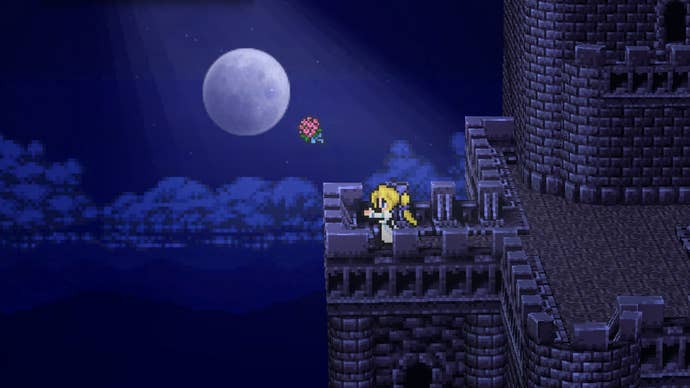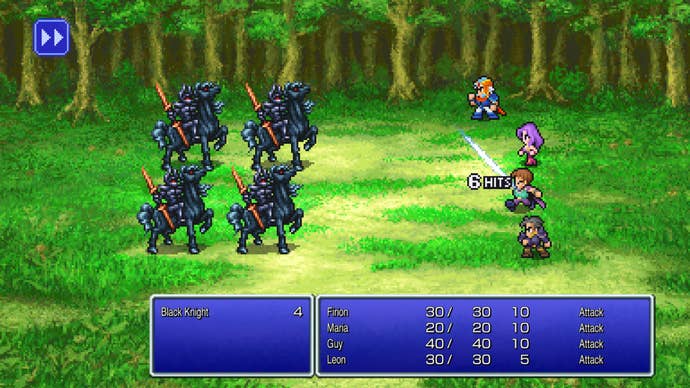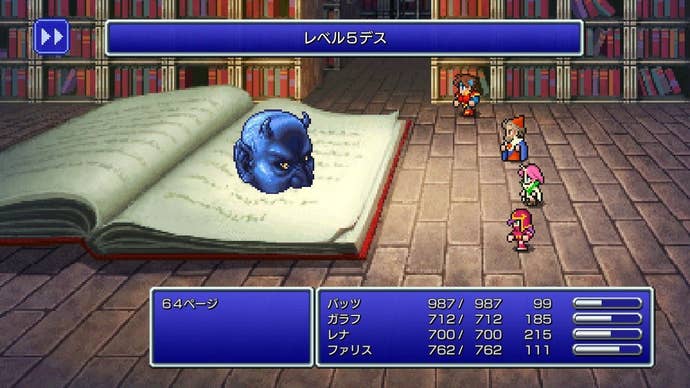Final Fantasy 1-6 Pixel Remaster console creeps closer to definitive status, despite some small frustrations
The Final Fantasy Pixel Remasters are notably improved over the PC versions, even if they are still carrying a bit of baggage.
After months of fans pleading with Square Enix to do so on social media, the Final Fantasy Pixel Remasters are finally hitting consoles - available this week for PlayStation 4 and Nintendo Switch. And intriguingly, these aren’t functionally the same versions as debuted on PC and mobile. In fact, they’re subtly improved.
These are small changes, but they add up to something greater. It pushes these titles ever closer to being very nearly the definitive versions of classics. In fact, hardcore fans will now likely have a headache on their hands deciding which version of each 2D FF to play.
For the most part, our original review of the first three games stands. Back in 2021, I said these ports had vast room for improvement. The console versions are improved… but there’s still many areas where they could - and arguably should - do better. Nevertheless, they’re now far more worthy versions of these classic games.
First up, performance: we’ve only tested on Switch, and it’s adequate, but far from perfect. Stuttering is still far too common for my tastes - and I don’t get why it’s happening on games this old. It’s there out of the gate; my Switch OLED hung up for a good half a second during the openings of both FF1 and FF6. This was replicable, too, happening every time I restarted in exactly the same scenes. Many of these problems were also exhibited even on PC, and it’s sort of bizarre to see hitching in a game that is ostensibly 35 years old.
More pleasing are the all-new features, however. And Square Enix has announced that it will be bringing these new features to the PC version of the game(s), too.
The first of the new features are the Boosters. These are accessed via a new option that can be nabbed at any time from the field. So long as you can open your main menu, which is most of the time out of battle, you can head to the ‘Configuration’ submenu and in there find a new header called ‘Boost’.

There’s three different Boosts found in this menu for all six games: Encounters, EXP, and Gil. Encounters can be turned on or off, while you can adjust the amount of EXP or Gil you received from winning battles by 0.5x, 2x, or 4x - as well as set it back to 1x, the default setting.
Specific games get bonus boosts, however. In FF2 you can toggle on or off the ‘compensatory HP’ bonus that auto-boosts your maximum HP after a certain amount of battles, as well as helping-hand buffs to physical and magic attack stats. FF5 and FF6 have options to increase the ABP and Magic AP gained respectively in addition to EXP and Gil - meaning you can obtain Esper Skills and Job Abilities more quickly within those games systems.
This is all really useful, and the integration of just popping this in the menu feels more elegant and less disruptive than the modern PS1 FF remasters, which hid the boosters behind controller shortcuts and noted their status with ugly icons on the side of the play area. It’s not as quick to turn these on or off, but the fact you can do so without closing the game is great. If you find you need to grind, or are short on cash, you can now up the currency gain rate easily - and then turn encounters off if you want to breeze through a dungeon. Thumbs way up - a great addition.

Earlier on I mentioned how the rearranged music offered in these remasters is incredible, and it remains so - but if you disagree, there’s a new option just for you. Buried in the same configuration menu is a new music toggle that lets you flick between the original soundtracks as they appeared on NES and SNES and the arranged score. This, again, can be toggled at any time with little consequence - so if you’re a newcomer wondering how that head-banging boss theme sounded with only 4 channels, you can flick open in time for the next boss.
I love this change. This is the sort of thing the Pixel Remasters should be going all-in on. These games have existed in many forms over the years, so why not include all of the available content and let players customize their experience? This sentiment speaks to what the Pixel Remasters don’t get right, too - but more on that in a moment.
First, though, let’s talk about the font. That bloody font. After fan complaints and fan-made solutions for how to replace the truly terrible font in the original PC and mobile releases, Square Enix has taken notice and offered a replacement.
It’s one of a few complaints the developers have directly addressed, including a patch to the PC and mobile versions (also present here) that adjusted the overly-bright color palette of FF6’s cast sprites, and reinstating developer credits to the opening crawl of FF6 (new for the console version, though notably still not the original credits but rather those specifically for the Pixel Remaster staff). But the chief mea culpa is undoubtedly the font.

While the games still default to the font we all hated, you can toggle fonts in the menu to a more title-appropriate pixelated text presentation. It looks nice - but I’m still a little disappointed with it.
Part of it is being spoiled by fan-made masterpieces, really. I personally played through all six Pixel Remasters with a fan-made font inspired by the SNES version of Final Fantasy VI created by modder ‘Bdjeffyp’ - and it’s a magnificent-looking thing. Another particularly magnificent font is the ‘Cornelia Sans’ font, a recreation of the font Square themselves used for Final Fantasy Origins back on PS1.
The new font in the Pixel Remasters is a definite improvement, with the pixelated stuff undeniably better than the generic default operating system style font we got before. But it’s also guilty of many of the same sins as the hated font - just in a pixelated form. The kerning of the new font is still terrible, for instance. And in many menus it feels poorly vertically aligned, a little too high so it’s not quite in the middle of text boxes.
A picture speaks a thousand words - so here’s a comparison between the PC original font, Square’s replacement, and one of my favorite fan mods, borrowed from our friends over at RPG Site. Judge for yourself.

Or to put it another way, the Pixelated look is a better fit for these releases, and is exactly the sort of font these releases should’ve had from day one. However, the presentation and stylings of this version still sort of sucks. That’s a shame.
So, that’s one weird little bump in the road for this otherwise delightful package. Another sits in its feature set, which comes back to what was mentioned earlier about the vast amounts of content from other versions of these games.
Some of it hasn’t aged well, like the CG cutscenes added to the PlayStation versions. The musical arrangements from those versions are largely redundant, too. As such, I can understand getting rid of these, though it would be nice to have them available to watch or listen to in a menu, just to help this feel like a definitive collection.
The main thing I miss, however, is the bonus content that was for the most part added on GBA. Exactly what is missing varies for each game, but generally speaking it comprises late or post-game challenge dungeons with unique twists on the established rules of each title’s combat systems. This content was generally a reward for the most hardcore fans - stretching each battle system to its limits and also often offering some neat fanservice, like fighting bosses from other games.
A couple of bits are particularly sad to lose. FF2’s Soul of Rebirth was an entirely separate post-game epilogue tying up some of the main game’s loose ends while even featuring a new party member - a painful loss. FF5’s main bonus dungeon allowed players to unlock four all-new jobs for characters to try out. And FF6 had the best end-game content, with new super-bosses offering up drops of new ultimate weapons. There’s also a few exciting additional unlockable Espers including Gilgamesh and FF8’s Diabolos.

A lot of it is really bonuses for the true hardcore nerds, and if you just want to play the stories of each game, you’ll be served well here. But equally, if you’re a sucker for FF battle systems and want to explore each to their fullest, the list of absent content stings.
In truth, I understand the logic of wanting to present remasters that resemble the SNES and NES originals accurately. But I also think options are the lifeblood of remasters like this - so players should have this content in, toggleable. Plus - with redrawn sprites, rearranged music, a 16:9 presentation, and numerous balance changes, the concept of being original-accurate is a long-sailed ship anyway.
And yet, let’s be fair: this is an irresistible package, especially if you don’t have access to a PC or Steam Deck, where you can easily mod in some better text options. These are incredible games, finally available in a respectable form on more platforms than they’ve been available on in decades. We can’t really treat this as anything other than a net win.
For the truly snooty hardcore, of which I am undoubtedly one, I still think there’s a strong case for the best versions of all of these games but FF3 being the GBA carts played on some sexy neo-retro hardware like the Analogue Pocket - but short of that particularly expensive indulgence, this is now a vastly improved and much more worthy way to experience six stone-cold classics. I just wish - I really do wish they were truly definitive. Maybe one day, hey?

